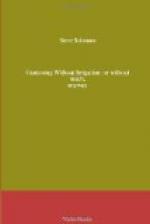Soil’s Water-Holding Capacity
Soil is capable of holding on to quite a bit of water, mostly by adhesion. For example, I’m sure that at one time or another you have picked up a wet stone from a river or by the sea. A thin film of water clings to its surface. This is adhesion. The more surface area there is, the greater the amount of moisture that can be held by adhesion. If we crushed that stone into dust, we would greatly increase the amount of water that could adhere to the original material. Clay particles, it should be noted, are so small that clay’s ability to hold water is not as great as its mathematically computed surface area would indicate.
Surface Area of One Gram of Soil Particles
Particle type Diameter of particles in mm Number of
particles per gm
Surface area in sq. cm.
Very coarse sand 2.00-1.00 90 11
Coarse sand 1.00-0.50 720 23
Medium sand 0.50-0.25 5,700 45
Fine sand 0.25-0.10 46,000 91
Very fine sand 0.10-0.05 772,000 227
Silt 0.05-0.002 5,776,000 454
Clay Below 0.002 90,260,853,000 8,000,000
Source: Foth, Henry D., Fundamentals of Soil Science, 8th ed.
(New York: John Wylie & Sons, 1990).
This direct relationship between particle size, surface area, and water-holding capacity is so essential to understanding plant growth that the surface areas presented by various sizes of soil particles have been calculated. Soils are not composed of a single size of particle. If the mix is primarily sand, we call it a sandy soil. If the mix is primarily clay, we call it a clay soil. If the soil is a relatively equal mix of all three, containing no more than 35 percent clay, we call it a loam.
Available Moisture (inches of water per foot of soil)
Soil Texture Average Amount
Very coarse sand 0.5
Coarse sand 0.7
Sandy 1.0
Sandy loam 1.4
Loam 2.0
Clay loam 2.3
Silty clay 2.5
Clay 2.7
Source: Fundamentals of Soil Science.
Adhering water films can vary greatly in thickness. But if the water molecules adhering to a soil particle become too thick, the force of adhesion becomes too weak to resist the force of gravity, and some water flows deeper into the soil. When water films are relatively thick the soil feels wet and plant roots can easily absorb moisture. “Field capacity” is the term describing soil particles holding all the water they can against the force of gravity.
At the other extreme, the thinner the water films become, the more tightly they adhere and the drier the earth feels. At some degree of desiccation, roots are no longer forceful enough to draw on soil moisture as fast as the plants are transpiring. This condition is called the “wilting point.” The term “available moisture” refers to the difference between field capacity and the amount of moisture left after the plants have died.




